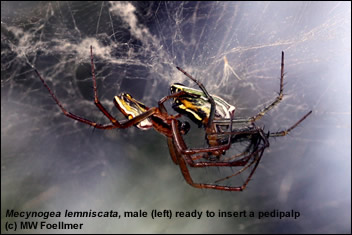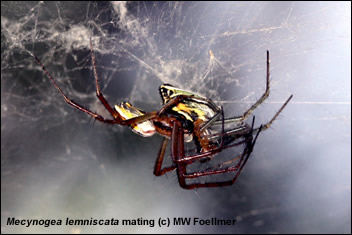| Matthias W. Foellmer |  |
Evolutionary Ecology and Diversity of Spiders |
||||||
|---|---|---|---|---|---|---|---|---|
|
|
||||||||
| Mating systems | |
In most animal species males can increase their fitness by mating with several females (sperm is relatively cheap to produce and male reproductive success is, unlike that of females, generally not limited by the number of gametes they produce). Most mating systems are accordingly characterized by males that mate with multiple females and that exhibit a high variance in reproductive success. However, in several insect and spider species males mate with only one female - in the absence of any paternal care provided. In such species males often make a terminal mating investment by emasculating themselves (leaving parts of their copulatory organs behind in the females copulatory tract) or by sacrificing themselves by offering themselves as a meal to the females or by simply dying in copula. The benefits of such a terminal investment appears to be the avoidance of sperm competition with ejaculates from other males by plugging the female and/or reducing the female’s propensity to mate again. |
 |
Mathematical models suggest that a combination of male-biased effective sex ratios (which may be a by-product of the evolution of extreme female-biased SSD) and a high male mortality during mate search favors the evolution of monogyny, but empirical data to support this are still scarce. |
|
Species in the genus Argiope are famous for their peculiar mating habits: males emasculate themselves and in several species males die spontaneously upon insertion of their second pedipalp. In addition, the females are very likley to attack males during copulation (sexual cannibalism), which can be detrimental to the male's fitness if this happens during the insertion of a male's first pedipalp. For current and past projects see Publications and People. |
|
 |
|
 |
|